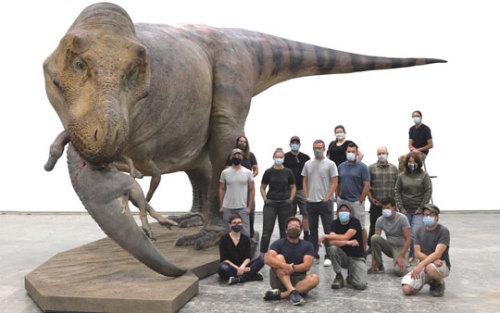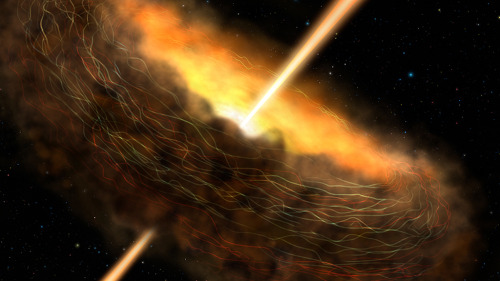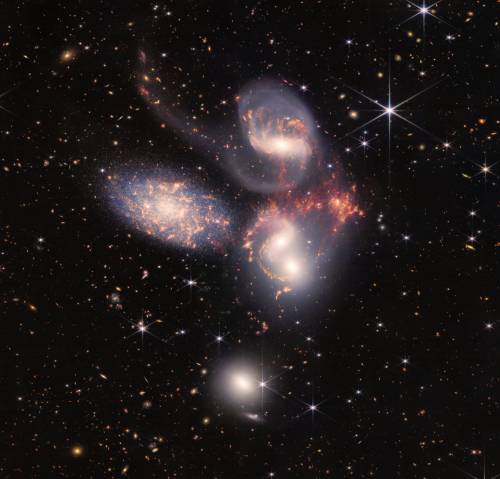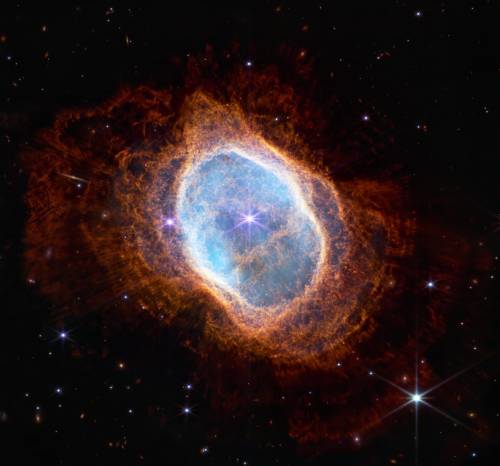Primordialbitch

More Posts from Primordialbitch and Others
Celebrate #BlackHoleFriday with Nurturing Baby Stars

Are you throwing all your money into a black hole today?
Forget Black Friday — celebrate #BlackHoleFriday with us and get sucked into this recent discovery of a black hole that may have sparked star births across multiple galaxies.
If confirmed, this discovery would represent the widest reach ever seen for a black hole acting as a stellar kick-starter — enhancing star formation more than one million light-years away. (One light year is equal to 6 trillion miles.)
A black hole is an extremely dense object from which no light can escape. The black hole’s immense gravity pulls in surrounding gas and dust. Sometimes, black holes hinder star birth. Sometimes — like perhaps in this case — they increase star birth.
Telescopes like our Chandra X-ray Observatory help us detect the X-rays produced by hot gas swirling around the black hole. Have more questions about black holes? Click here to learn more.
Make sure to follow us on Tumblr for your regular dose of space: http://nasa.tumblr.com.
Red paint on 1,000-year-old gold mask from Peru contains human blood proteins

Thirty years ago, archeologists excavated the tomb of an elite 40-50-year-old man from the Sicán culture of Peru, a society that predated the Incas. The man’s seated, upside-down skeleton was painted bright red, as was the gold mask covering his detached skull. Now, researchers reporting in ACS’ Journal of Proteome Research have analyzed the paint, finding that, in addition to a red pigment, it contains human blood and bird egg proteins.
The Sicán was a prominent culture that existed from the ninth to 14th centuries along the northern coast of modern Peru. During the Middle Sicán Period (about 900–1,100 A.D.), metallurgists produced a dazzling array of gold objects, many of which were buried in tombs of the elite class. In the early 1990s, a team of archaeologists and conservators led by Izumi Shimada excavated a tomb where an elite man’s seated skeleton was painted red and placed upside down at the center of the chamber. Read more.

Extinct tree grows anew from ancient jar of seeds unearthed by archaeologists
by Stephen Messenger
“For thousands of years, Judean date palm trees were one of the most recognizable and welcome sights for people living in the Middle East — widely cultivated throughout the region for their sweet fruit, and for the cool shade they offered from the blazing desert sun.
From its founding some 3,000 years ago, to the dawn of the Common Era, the trees became a staple crop in the Kingdom of Judea, even garnering several shout-outs in the Old Testament. Judean palm trees would come to serve as one of the kingdom’s chief symbols of good fortune; King David named his daughter, Tamar, after the plant’s name in Hebrew.
By the time the Roman Empire sought to usurp control of the kingdom in 70 AD, broad forests of these trees flourished as a staple crop to the Judean economy — a fact that made them a prime resource for the invading army to destroy. Sadly, around the year 500 AD, the once plentiful palm had been completely wiped out, driven to extinction for the sake of conquest.
In the centuries that followed, first-hand knowledge of the tree slipped from memory to legend. Up until recently, that is.
During excavations at the site of Herod the Great’s palace in Israel in the early 1960’s, archeologists unearthed a small stockpile of seeds stowed in a clay jar dating back 2,000 years. For the next four decades, the ancient seeds were kept in a drawer at Tel Aviv’s Bar-Ilan University. But then, in 2005, botanical researcher Elaine Solowey decided to plant one and see what, if anything, would sprout.
“I assumed the food in the seed would be no good after all that time. How could it be?“ said Solowey. She was soon proven wrong.
Amazingly, the multi-millennial seed did indeed sprout — producing a sapling no one had seen in centuries, becoming the oldest known tree seed to germinate.
Today, the living archeological treasure continues to grow and thrive; In 2011, it even produced its first flower — a heartening sign that the ancient survivor was eager to reproduce. It has been proposed that the tree be cross-bred with closely related palm types, but it would likely take years for it to begin producing any of its famed fruits. Meanwhile, Solowey is working to revive other age-old trees from their long dormancy.”
***Does anyone in the know have any comments?
(Source: Tree Hugger)
TRAILER: “NO BLADE OF GRASS” (1970)
This adaptation of John Christopher’s novel “The Death of Grass” was co-written, directed and produced by Cornel Wilde. It’s a British/American co-production starring Nigel Davenport, Jean Wallace, and John Hamill.
It follows the survivors of a plague that has hit London in the not too distant future - at least the future not too distant from 1970. When London is overwhelmed by food riots caused by a global famine, a man tries to lead his family to safety in Westmorland. The family is joined by a violent man and his girlfriend as they try to leave before martial law and complete anarchy ensue.
As we’ve been discussing in our ongoing podcast series “Sci Fi Time Capsule”, there’s no era of science fiction film quite like the 1970s.
“No Blade of Grass” is a bit of a rare film, but you can buy it on DVD or stream it on Apple TV, Amazon Prime Video, and The Criterion Channel.
Unveiling the Center of Our Milky Way Galaxy

We captured an extremely crisp infrared image of the center of our Milky Way galaxy. Spanning more than 600 light-years, this panorama reveals details within the dense swirls of gas and dust in high resolution, opening the door to future research into how massive stars are forming and what’s feeding the supermassive black hole at our galaxy’s core.

Among the features coming into focus are the jutting curves of the Arches Cluster containing the densest concentration of stars in our galaxy, as well as the Quintuplet Cluster with stars a million times brighter than our Sun. Our galaxy’s black hole takes shape with a glimpse of the fiery-looking ring of gas surrounding it.
The new view was made by the world’s largest airborne telescope, the Stratospheric Observatory for Infrared Astronomy, or SOFIA.
Make sure to follow us on Tumblr for your regular dose of space: http://nasa.tumblr.com.
Here’s one good thing to come out of 2020:
Paleontologists completed a life-sized replica of Sue, the most complete T. Rex ever found.

And she is freaking GORGEOUS!
As I read more about this beauty, I found out some new details regarding things I thought I previously knew about the beast that was Tyrannosaurus Rex, and I’m going to share them with you.
First, and most obvious, her size:

This is nothing new, we all figured T. Rex was big, but I for one never stopped to consider exactly how big it was. Nobody ever really knows what to imagine when they read about something the size of a whale that walked around and ate everything it could kill.
Speaking of eating things, I just want to remind you all that T. Rex had–by miles–the strongest bite of any terrestrial animal living or dead, somewhere around six and a half tons of force. That’s over six times greater than the current estimate of what Allosaurus was capable of, and three times what was delivered by the highest measured reading of the living title holder–the estuarine crocodile. It didn’t have to waste time swinging its head open-mouthed like Saurophaganax for a little extra oomph, or grow fancy serrated teeth like Carcharodontosaurus to cut pieces out of its prey. It opted for the simplest approach: get its mouth around something and crush it to death; imagine the full weight of an elephant on whatever was between this thing’s jaws.
“How did it find something to eat?” I hear you asking. “It can’t see something if it doesn’t move, right?”
Listen, I love Jurassic Park too, but that’s a big crock of shit.

Notice how both her eyes face forward. That gives her binocular vision (the ability to focus both eyes on one target, like you and I). More importantly it means she has impeccable depth perception due to overlapping fields of vision from each, large, eyeball. Researchers agree that T. Rex not only had incredible vision, but that it was probably better than most modern animals–including eagles, hawks, and owls–and that she could likely spot something three and a half miles away. If something that big can see that well, it doesn’t matter if you move or not, she’d be able to tell if it was an animal trying to hide or a piece of vegetation. So pray she isn’t hungry if she lays eyes on you. And even if by some miracle she didn’t see you, she’d still smell you.
If she decided you looked tasty, you probably wouldn’t hear her coming as much as you’d feel her. Modern science indicates that T. Rex didn’t roar like in Jurassic Park, but rather bellowed or maybe even hissed like crocodilians. If she were on to you, you’d most likely feel this sense of unease creep up your spine as a low-pitched rumble in the air permeated through you. You wouldn’t know what it was or where it was coming from until you hear her footfalls. By then it’s too late–you could try to run but she’d probably catch you. There’s plenty on YouTube that reconstructs what T. Rex may have sounded like, and it’s legitimately haunting.
To wrap all of this up, the one bit of good that came out of the cursed year that is 2020 is that this wonderful child of science and art came into the world, and reaffirmed my respect and admiration for the eight ton slab of muscle and teeth that is this magnificent creature.

…and it is nothing if not magnificent.
10 Amazing Space Discoveries by the World’s Largest Flying Observatory

On the night of May 26, 2010, the Stratospheric Observatory for Infrared Astronomy, or SOFIA, the world’s largest flying observatory, first peered into the cosmos. Its mission: to study celestial objects and astronomical phenomena with infrared light. Many objects in space emit almost all their energy at infrared wavelengths. Often, they are invisible when observed in ordinary, visible light. Over the last decade, the aircraft’s 106-inch telescope has been used to study black holes, planets, galaxies, star-forming nebulas and more! The observations have led to major breakthroughs in astronomy, revolutionizing our understanding of the solar system and beyond. To celebrate its 10 years of exploration, here’s a look at the top 10 discoveries made by our telescope on a plane:
The Universe’s First Type of Molecule

Scientists believe that around 100,000 years after the big bang, helium and hydrogen combined to make a molecule called helium hydride. Its recent discovery confirms a key part of our basic understanding of the early universe.
A New View of the Milky Way

More than a pretty picture, this panorama of cosmic scale reveals details that can help explain how massive stars are born and what’s feeding our Milky Way galaxy’s supermassive black hole.
When Planets Collide

A double-star system that is more than 300 light-years away likely had an extreme collision between two of its rocky planets. A similar event in our own solar system may have formed our Moon.
How A Black Hole Feasts

Fear not, the dark, my friend. And let the feast begin! Magnetic fields in the Cygnus A galaxy are trapping material where it is close enough to be devoured by a hungry black hole.
Somewhere Like Home

The planetary system around Epsilon Eridani, a star located about 10 light-years away, has an architecture remarkably similar to our solar system. What’s more, its central star is a younger, fainter version of our Sun.
A Quiet Place

Black holes in many galaxies are actively consuming material, but our Milky Way galaxy’s central black hole is relatively quiet. Observations show magnetic fields may be directing material around, not into, the belly of the beast.
The Great Escape

Ever wonder how material leaves a galaxy? The wind flowing from the center of the Cigar Galaxy is so strong it’s pulling a magnetic field — and the mass of 50 to 60 million Suns — with it.
Exploding Star, New Worlds

What happens when a star goes boom? It turns out that supernova explosions can produce a substantial amount of material from which planets like Earth can form.
Stellar Sibling Rivalry

They say siblings need time and space to grow, but here’s one that really needs some room. A newborn star in the Orion Nebula is clearing a bubble of space around it, preventing any new luminous family members from forming nearby.
Clues to Life’s Building Blocks

Radiation from stars is making organic molecules in nebula NGC 7023, also known as the Iris Nebula, larger and more complex. The growth of these molecules is one of the steps that could lead to the emergence of life under the right circumstances.
SOFIA is a modified Boeing 747SP aircraft that allows astronomers to study the solar system and beyond in ways that are not possible with ground-based telescopes. Find out more about the mission at www.nasa.gov/SOFIA.
Make sure to follow us on Tumblr for your regular dose of space: http://nasa.tumblr.com



NASA’s Webb Space Telescope Reveals Astounding, Unprecedented Views of the Universe
Faint starlight in Hubble images reveals distribution of dark matter
Astronomers using data from the NASA/ESA Hubble Space Telescope have employed a revolutionary method to detect dark matter in galaxy clusters. The method allows astronomers to “see” the distribution of dark matter more accurately than any other method used to date and it could possibly be used to explore the ultimate nature of dark matter. The results were published in the journal Monthly Notices of the Royal Astronomical Society.

In recent decades astronomers have tried to understand the true nature of the mysterious substance that makes up most of the matter in the Universe – dark matter – and to map its distribution in the Universe. Now two astronomers from Australia and Spain have used data from the Frontier Fields programme of the NASA/ESA Hubble Space Telescope to accurately study the distribution of dark matter.
Keep reading
-
 particle-acchellerator reblogged this · 2 weeks ago
particle-acchellerator reblogged this · 2 weeks ago -
 particle-acchellerator liked this · 2 weeks ago
particle-acchellerator liked this · 2 weeks ago -
 piggiequackquack liked this · 1 month ago
piggiequackquack liked this · 1 month ago -
 geniusandmadnessblog liked this · 1 month ago
geniusandmadnessblog liked this · 1 month ago -
 aluade liked this · 1 month ago
aluade liked this · 1 month ago -
 disappointmint liked this · 2 months ago
disappointmint liked this · 2 months ago -
 gfas reblogged this · 2 months ago
gfas reblogged this · 2 months ago -
 taffycandyqt liked this · 2 months ago
taffycandyqt liked this · 2 months ago -
 nullingvoidreblogs reblogged this · 2 months ago
nullingvoidreblogs reblogged this · 2 months ago -
 slaaplekker reblogged this · 2 months ago
slaaplekker reblogged this · 2 months ago -
 slaaplekker liked this · 2 months ago
slaaplekker liked this · 2 months ago -
 anita1986s liked this · 2 months ago
anita1986s liked this · 2 months ago -
 windchimelilly reblogged this · 4 months ago
windchimelilly reblogged this · 4 months ago -
 windchimelilly liked this · 4 months ago
windchimelilly liked this · 4 months ago -
 catsinspacesuits liked this · 4 months ago
catsinspacesuits liked this · 4 months ago -
 thunderstorms-and-a-lover reblogged this · 5 months ago
thunderstorms-and-a-lover reblogged this · 5 months ago -
 fandompain reblogged this · 5 months ago
fandompain reblogged this · 5 months ago -
 humanityinahandbag liked this · 5 months ago
humanityinahandbag liked this · 5 months ago -
 annita89ecdwc7hsh liked this · 6 months ago
annita89ecdwc7hsh liked this · 6 months ago -
 felix16712 liked this · 6 months ago
felix16712 liked this · 6 months ago -
 dearlybeloved-dreameater reblogged this · 6 months ago
dearlybeloved-dreameater reblogged this · 6 months ago -
 anna0orcp liked this · 6 months ago
anna0orcp liked this · 6 months ago -
 angelch55 liked this · 6 months ago
angelch55 liked this · 6 months ago -
 righteousimperator liked this · 8 months ago
righteousimperator liked this · 8 months ago -
 j-restlessgeek reblogged this · 8 months ago
j-restlessgeek reblogged this · 8 months ago -
 j-restlessgeek liked this · 8 months ago
j-restlessgeek liked this · 8 months ago -
 vampirecatprince liked this · 8 months ago
vampirecatprince liked this · 8 months ago -
 polteergeistt liked this · 8 months ago
polteergeistt liked this · 8 months ago -
 luce-goose reblogged this · 8 months ago
luce-goose reblogged this · 8 months ago -
 luce-goose liked this · 8 months ago
luce-goose liked this · 8 months ago -
 yesandpeeps reblogged this · 8 months ago
yesandpeeps reblogged this · 8 months ago -
 myloveshack liked this · 8 months ago
myloveshack liked this · 8 months ago -
 rrodey liked this · 9 months ago
rrodey liked this · 9 months ago -
 takemetodragonstone liked this · 10 months ago
takemetodragonstone liked this · 10 months ago -
 saint-of-all-sinners reblogged this · 10 months ago
saint-of-all-sinners reblogged this · 10 months ago -
 saint-of-all-sinners liked this · 10 months ago
saint-of-all-sinners liked this · 10 months ago -
 nosleepgummitato liked this · 10 months ago
nosleepgummitato liked this · 10 months ago -
 mtnsnx liked this · 10 months ago
mtnsnx liked this · 10 months ago -
 natureofidentity liked this · 10 months ago
natureofidentity liked this · 10 months ago -
 devourerofmugsofcoffe liked this · 10 months ago
devourerofmugsofcoffe liked this · 10 months ago -
 deadpoop27 reblogged this · 10 months ago
deadpoop27 reblogged this · 10 months ago -
 deadpoop27 liked this · 10 months ago
deadpoop27 liked this · 10 months ago -
 moon-childs-universe reblogged this · 10 months ago
moon-childs-universe reblogged this · 10 months ago -
 twilabellas reblogged this · 10 months ago
twilabellas reblogged this · 10 months ago -
 twilabellas liked this · 10 months ago
twilabellas liked this · 10 months ago -
 witchklng reblogged this · 10 months ago
witchklng reblogged this · 10 months ago -
 manqoz liked this · 10 months ago
manqoz liked this · 10 months ago

